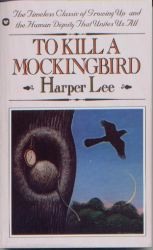35 books everyone should read at least once in their lifetime
 This article arose from a question posed on Reddit: “What is a book that everyone needs to read at least once in their life?”
This article arose from a question posed on Reddit: “What is a book that everyone needs to read at least once in their life?”
Of the top 35 books listed here from the Reddit responses, I have read the following:
- Zen and the Art of Motorcycle Maintenance by Robert M. Pirsig
- Man’s Search for Meaning by Viktor Frankl
- Bartleby The Scrivener: A Story of Wall-Street by Herman Melville
- East of Eden by John Steinbeck
- How to Win Friends and Influence People by Dale Carnegie (hey, it was a requirement of my psych 101 course in college)
- Crime and Punishment by Fyodor Dostoyevsky
- The Stranger by Albert Camus
- The Handmaid’s Tale by Margaret Atwood
- Anne of Green Gables by L.M. Montgomery
Fahrenheit 451 by Ray Bradbury - To Kill A Mockingbird by Harper Lee
- Animal Farm by George Orwell
- All Quiet on the Western Front by Erich Maria Remarque
Catch–22 by Joseph Heller - Slaughterhouse Five by Kurt Vonnegut
- The Hitchhiker’s Guide to the Galaxy by Douglas Adams
- Flowers for Algernon by Daniel Keyes
- 1984 by George Orwell
That’s fewer than half. How depressing.
In my defense, though, I do have several of the others on my personal to-be-read list:
- Watership Down by Richard Adams
- For Whom the Bell Tolls by Ernest Hemingway
- One Hundred Years of Solitude by Gabriel Garcia Marquez
- The Brothers Karamazov by Fyodor Dostoyevsky
- Dune by Frank Herbert (I have resisted this one for years but have finally decided I should give it a try)
- Do Androids Dream of Electric Sheep? by Philip K. Dick (can’t believe I haven’t read this yet)
So many books, so little time…
Romanticizing the Reader
Writer Diane Ackerman looks at the relationship between writers and their readers:
Nearly every author I know imagines one or more readers while writing a book. It’s a bloom of creative telepathy. The reader is a part of yourself, held at a distance, and becomes an important sounding board for the tone and language of the pages, an intimate ally.
And how do readers react when meeting authors, for example at a book signing? “Having read your books, readers know you far better than you know them — except that authors aren’t always their books.” She continues, “And just as the author romanticizes the reader, so does the reader romanticize the author.”
In the end, both the writer and the reader—and the interaction between the two—are necessary for a book to be successful:
As an author and reader, I like the idea of reading as an indelible spice that transforms a book while the book transforms you.
Literary Idol: Amelia Gray on Shirley Jackson
In conjunction with the recent Los Angeles Festival of Books, the Los Angeles Times asked five participants to comment on the writers who had influenced them. Here author Amelia Gray pays tribute to Shirley Jackson:
The loners in her books appealed to me, the fragile and friendless women in worlds built to appear ordinary that always revealed a more sinister nature.
This article contains links to lots of related coverage of the Festival of Books.
The eeriness of the English countryside
Writers and artists have long been fascinated by the idea of an English eerie – ‘the skull beneath the skin of the countryside’. But for a new generation this has nothing to do with hokey supernaturalism – it’s a cultural and political response to contemporary crises and fears
Robert Macfarlane has written a fascinating look at how the English landscape continues to be used artistically to represent the eerie:
that form of fear that is felt first as unease, then as dread, and which is incited by glimpses and tremors rather than outright attack. Horror specialises in confrontation and aggression; the eerie in intimation and aggregation. Its physical consequences tend to be gradual and compound: swarming in the stomach’s pit, the tell-tale prickle of the skin. I find the eerie far more alarming than the horrific…
He finds evidence of this eerie use of landscape in many artistic areas:
In music, literature, art, music, film and photography, as well as in new and hybrid forms and media, the English eerie is on the rise. A loose but substantial body of work is emerging that explores the English landscape in terms of its anomalies rather than its continuities, that is sceptical of comfortable notions of “dwelling” and “belonging”, and of the packagings of the past as “heritage”, and that locates itself within a spectred rather than a sceptred isle.
Although some of his references may be lost on those unfamiliar with both the English countryside and English history, his explanations make his meaning clear. He cites examples of such eerie works across literature, film, and art. Many of the current works call up earlier art and artists, from the 19th century forward. Many of these earlier works employed ghosts and corpses as symbolic of the decay underlying the seemingly tranquil pastoral landscape.
But engaging with the eerie emphatically doesn’t mean believing in ghosts. Few of the practitioners named here would endorse earth mysteries or ectoplasm. What is under way, across a broad spectrum of culture, is an attempt to account for the turbulence of England in the era of late capitalism. The supernatural and paranormal have always been means of figuring powers that cannot otherwise find visible expression. Contemporary anxieties and dissents are here being reassembled and re-presented as spectres, shadows or monsters…
As a Daughter Becomes a Teenager, a Mother Becomes a Vampire Novelist
Heather K. Gerken, the J. Skelly Wright professor of law at Yale Law School, has written eight novels, and is working on the ninth, that only one person will read:
My daughter is growing up, which means I’m losing her. Anna is 12, all eyes, cheekbones and imagination. Every now and then I catch a glimpse of the glorious 17-year-old just around the corner, and it makes my heart ache with the anticipation of loss.
Gerken started writing the books for her daughter because
I hope to encase Anna in the only form of armor that I trust — stories. I have written Anna as a heroine in the hope that she will feel the tug of her own heroism inside her.
Even though Anna hasn’t yet grown up, she’s now writing her own story, which Gerken takes as a good sign.
Her Stinging Critiques Propel Young Adult Best Sellers
You may have never heard of Julie Strauss-Gabel, but you’ve almost certainly heard of one example of her work, the novel The Fault in Our Stars by John Green. Strauss-Gabel is publisher of Dutton Children’s Books.
Amidst all the chest-thumping about the decline of the publishing industry, children’s books have been the bright exception: “In 2014, revenue from young adult and children’s books rose by 21 percent over the previous year, while adult fiction and nonfiction fell by 1.4 percent, according to the Association of American Publishers.”
Strauss-Gable has contributed significantly to the rise of YA (young adult) literature:
Ms. Strauss-Gabel’s unconventional taste and eye for idiosyncratic literary voices have helped her identify and build up some of young adult fiction’s biggest breakout stars.
Many adults now buy and read YA literature:
Adults aged 18 to 44 made up 65 percent of young adult book buyers in 2014, according to a recent Nielsen Books & Consumer survey, and men accounted for 44 percent of young adult book buyers in 2014, up from 31 percent in 2012. And 65 percent of adults buying young adult books reported that they were purchasing the books for themselves rather than for children.

